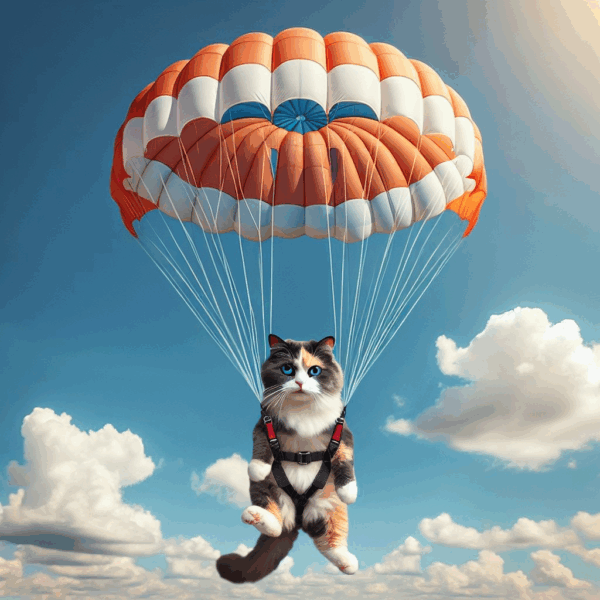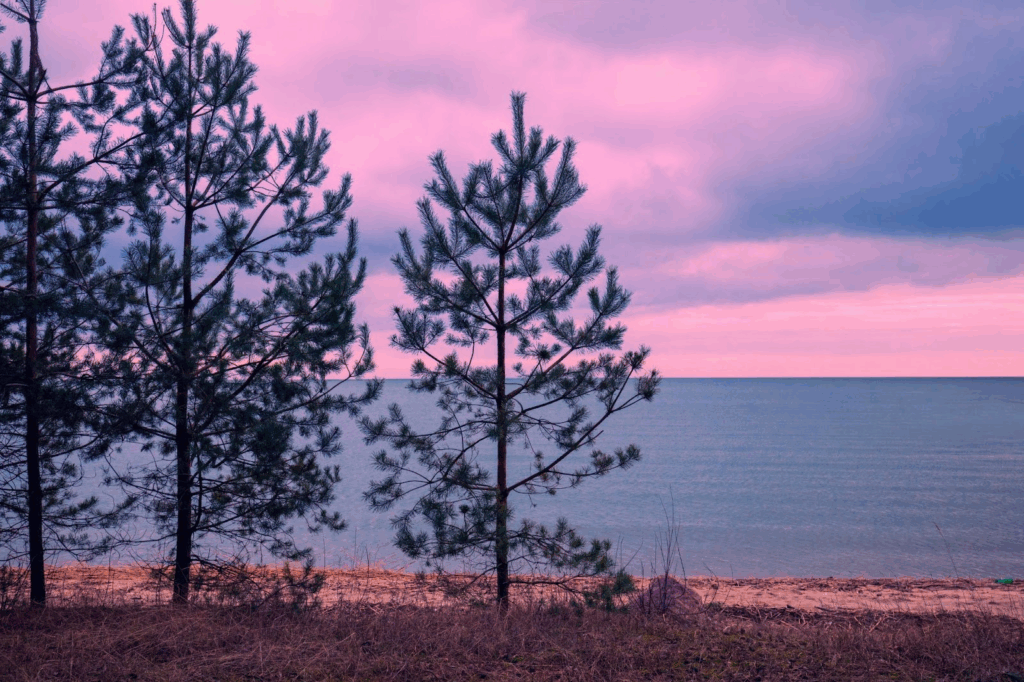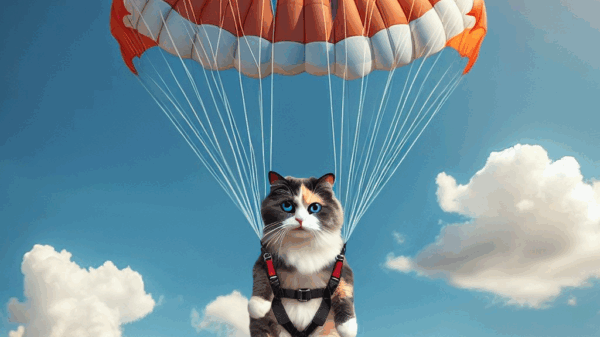1950’s Borneo. Malaria is rampant. The solution? Spray DDT. It works. The mosquitos die and malaria declines.
Unfortunately the thatch roofs on people’s houses collapse because the DDT also kills a parasitic wasp that eats the caterpillars that eat thatch. The government buys people new metal roofs but then no one can sleep because of the noise of the tropical rains on the metal.
The geckoes eat the poisoned bugs. Cats eat the newly poisonous geckoes. The cats die off and the rats have a field day leading to the risk of outbreaks of bubonic plague and typhus.
The World Health Organization, who starts this whole bacchanal, hires RAF Singapore to parachute cats into the Bornean rain forest. Some kitties go splat. Some survive.
Yes, this really happened.

Clearly, if we don’t want to air drop cats into jungles we need to be able to think in creative, non-linear fashions, so that our environmental solutions can deal with our complex realities. We need inspiration and creativity in the face of these challenges, not just to find solutions but also to empower people and confront their eco-anxieties. We make loads of movies with eco-Armageddons. Kids and adults are suffering from eco-phobia.
We need applied solutions to environmental problems and we need them now. Many exist, however, there is a vast and perilous shortage of inexpensive solutions for developing nations and at-risk communities. It’s pretty easy to be “Green,” if you’re rich (we’ll discuss greenwashing another time).
Much of the inspiration for this article came from, “Art and Creativity: Essential Components of Sustainability,” by Lukas Gutierrez. Key takeaways from the article:
- Art and creativity can help raise awareness about environmental issues and inspire people to take action.
- Art can reflect cultural attitudes toward the environment and promote equity and inclusivity, particularly among young people.
- Communications, marketing, and storytelling are powerful tools for promoting sustainability and influencing behavior change.
- Sustainability requires creativity and out-of-the-box thinking to develop new, more efficient ways to use resources and reduce waste.
- Sustainable practices and products need to be made more accessible and appealing to consumers through marketing strategies.
“Art and creativity have always been a source of inspiration for technological advancements. With the urgent need to transition to a sustainable future, this intersection of art and technology is becoming even more relevant. Green tech innovation and sustainability are two areas where art and creativity can play a vital role in inspiring new solutions.” (Lukas Gutierrez)
How do we build more creativity into environmental studies? Sir Ken Robinson defined creativity as “the process of having original ideas that have value”. He defined it as a process that can be taught. He called it “applied inspiration.” Others define creativity using two criteria: novelty and originality; and usefulness and appropriateness. We desperately need novel, original, useful, and appropriate solutions to environmental problems (and to address every point in The Robinson Manifesto actually).
In my experience with environmental work, how one constructs the PROBLEM impacts the chances of solutions. This is why I am fascinated with working with people to look at the ways in which they envision and analyze problems. It’s easy to miss things when variables range from the life cycles of wasps to roof materials and parachute harnesses for cats – from political pressure and professional reputations, to fungi living half way around the world.
In the 1970’s the Australian government decided it wanted to grow more trees for fiber in plantations. After extensive research and rigorous testing they decided to grow Monterey Pine (Pinus radiata), a lovely little tree from the California coast. When they planted out the first large quantities of the trees they didn’t grow. Bad. Very bad. A lot of money, time, professional reputations, and political capital had been invested in this program. Eventually it was discovered that these trees weren’t getting the nitrogen they needed even though the soil had nitrogen and the test plot trees were fine.
On the eve of a massive and expensive fertilization campaign (that they knew probably wasn’t going to work but they didn’t know what else to do) they contacted my Professor at UC Berkeley, Everett (Ev) Schlinger, an entomologist and plant pathologist. (Ev was a wonderful man who always had time for a hippie undergrad who asked too many questions). They’d already tried every scientist they knew and came up empty.
Ev investigated and found out that the big shipment of trees sent to Australia had been sterilized differently than the test trees had been, with a nasty chemical, for shipping. This killed a fungus that Monterey Pine cannot live without; a cool little mycorrhizal fungus that has partnered with Monterey pine for millions of years. They are buddies and need each other. Ev propagated some of the fungi, flew to Australia, and dumped it out of a little airplane flying low over the plantations. Problem solved – for a few thousand dollars rather than hundreds of thousands. A lot of scientists, technocrats, and politicians were greatly relieved. (Yes, I love these environmental detective stories).

We need creative thinking to solve our environmental problems. This isn’t a game. The clock is ticking. Thankfully, as Sir Ken pointed out, humans have created these problems, so humans can solve them. However, ‘We cannot deal with the environmental problems through thinking patterns that have created them in the first place. Too often, critical thinking confines itself to simply choosing among the pre-existing alternatives instead of imagining or creating new desirable values. We need to be not only critical, but also creative in the meaning-making…’ (Garrison, J., Östman, L., & Håkansson, M. 2015).
Very little creativity education is occurring within environmental academia. “Creativity education and environmental education are important research areas but remain far apart, with few efforts having been made to bring them closer together. Indeed, there has been little research on the potential for integrating these two educational areas.” (Vivian M.Y. Cheng. 2019)
We can’t just ask or expect students to be more creative. As the organization REDI Lab, co-founded by one of our Revolutionaries, Paul Kim, stated in a thought piece, “... I asked students to be creative, take risks, or work through open-ended questions. Without prior experience or permission to practice these skills, students typically struggled and gave up. It felt as if we were at an impasse.”
The gap between environmental education and creativity education puts our future at risk. It is an obstacle for everyone who wants to make a difference that is putting their careers and our futures in jeopardy. Education needs to revolutionize in this domain.
In part two of this article we will look at one way we can do this, through Critical Creativity, a blending of art and science using divergent thinking and creative problem solving, cognitive analysis and creative imagination to transform environmental science.
Part two next month. Thanks for your attention. Steven Greenleaf
Art and Creativity: Essential Components of Sustainability.” Lukas Gutierrez. April 21, 2023 https://sustainable-earth.org/art-and-creativity/ “The REDI Lab: Where Educators and Students Innovate Fearlessly.” November 12, 2024 https://redilab.org/where-educators-and-students-innovate-fearlessly/
Garrison, J., Östman, L., & Håkansson, M. (2015). The creative use of companion values in environmental education and education for sustainable development: Exploring the educative moment. Environmental Education Research, 21(2), 183–204.
“Developing individual creativity for environmental sustainability: Using an everyday theme in higher education.” Vivian M.Y. Cheng. 2019 https://www.sciencedirect.com/science/article/abs/pii/S1871187118301342
05 June 2025 Steven Greenleaf

I love this article, and how the author (and the various authors he quotes) so carefully elucidates how “everything is connected.” Art and Nature have always been deep passions of mine throughout my life, but I had perhaps never realized the necessity to inspire our “Critical Creativity” to the issue of environmental sustainability. As a Certified Ecopsychologist (Pacifica Graduate Institute, 2020), and an undergrad degree in Art Studio/Psychology/Sociology, these themes are “right up my alley,” as they say! I am deeply impressed with the depth of analysis and the defining of the essential issues involved in inspiring “out-of-the-box” problem-solving. I’m looking forward to reading further articles!!